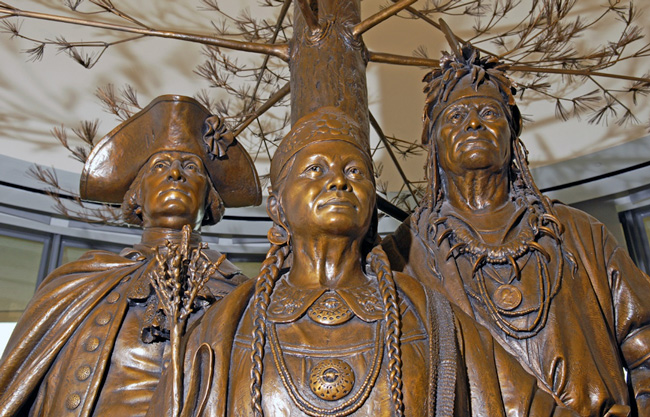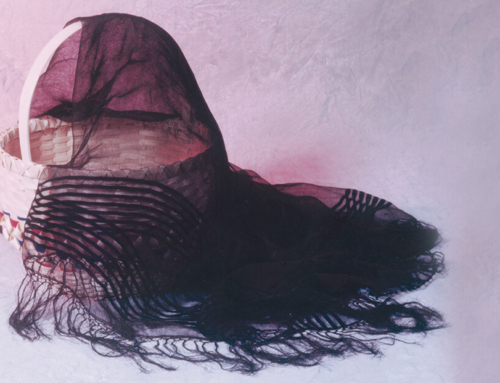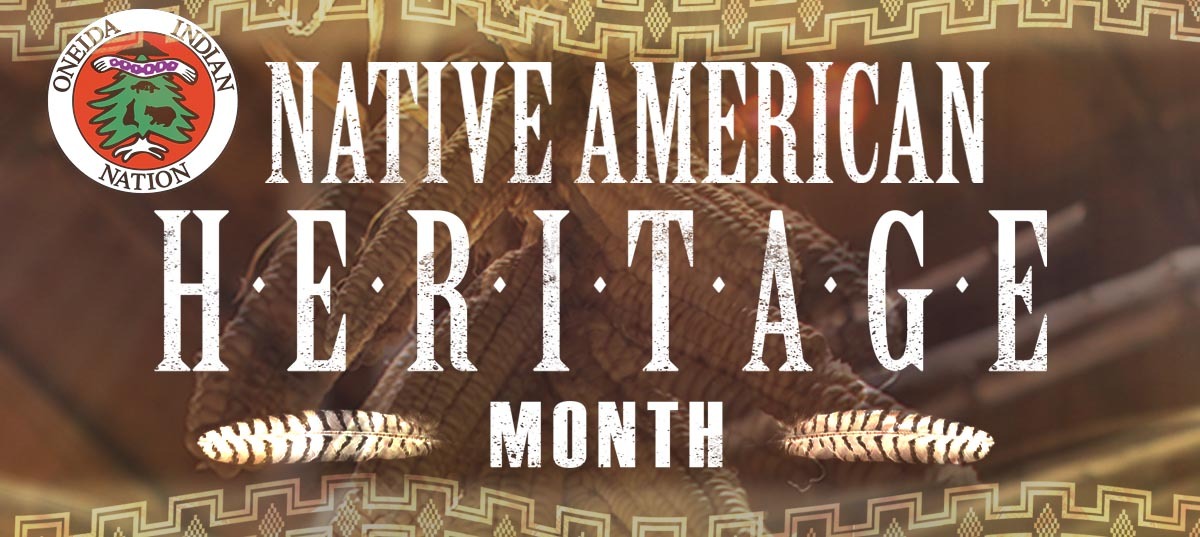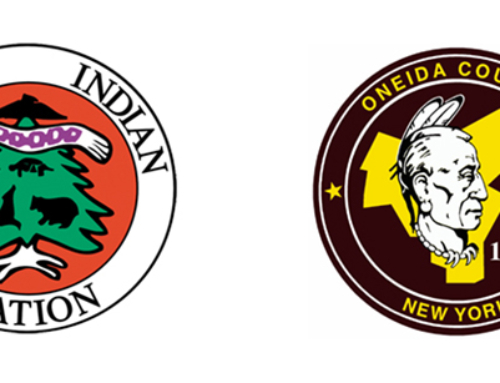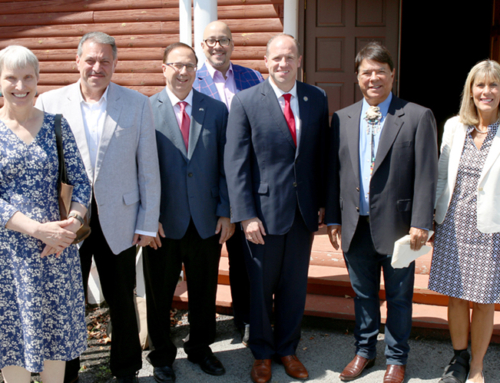Sculpture Celebrates Friendships Forged in the Past, Cemented in the Present and Promised for the Future
Visitors to the Smithsonian Institution’s National Museum of the American Indian in Washington, D.C. are encouraged to begin their tour on the fourth floor, the level named for the Oneida Indian Nation. Featured on this top floor is a pause area and in its confines is the statue “Allies in War, Partners in Peace,” a bronzed embodiment of the friendship that was forged between the Oneida Indian Nation and the United States during the Revolutionary War.
The 19-½ foot, 2,200 lb. statue created by Utah-based sculptor Edward Hlavka depicts Oneida Chief Shenendoah and an Oneida woman, Polly Cooper, along with Gen. George Washington. The statue is a commemoration of the bonds between two nations – the Oneida and the United States.
“We wanted a statue that would tell the story of how the Oneidas embraced the colonists’ cause of freedom, fighting beside their colonial friends and aiding them in their time of need,” said Keller George, Wolf Clan Representative to the Oneida Indian Nation’s Council, and a member of the board of trustees for the museum. “We also wanted symbols of importance in our culture to be allotted a presentation point, and I think the artist captured all these elements, telling our story as we have told it for generations.”
Oneidas fought alongside the colonists in key battles of the war, including Oriskany and Saratoga. The alliance was further cemented when a group of Oneidas walked from their home in Central New York to Valley Forge, a journey of more than 400 miles, during the winter of 1777-78, carrying life-saving corn to feed the starving soldiers. With them traveled Polly Cooper, who taught the soldiers how to prepare the corn. When the Oneida men returned to their homes, Polly Cooper remained and aided the troops. She would accept no payment for her services, but did accept a gift of a bonnet and shawl from Martha Washington. The shawl is still in existence today.
Shenendoah, also known as Skenandoah, is held in great esteem by the Nation and holds a deserving place in the statue. He was the wampum keeper and the inaugurator of government-to-government agreements. In addition, he played a major role in the Oneida Indian Nation’s decision to side with the colonists during the Revolutionary War. One reason Shenendoah chose to fight with the Americans was due to the friendship that existed between himself and the Rev. Samuel Kirkland, who was a missionary to the Oneidas and the founder of Hamilton College in Upstate New York. The friendship was so deep that Shenendoah asked to be buried next to Kirkland in the cemetery of the college.
One of Shenendoah’s prized possessions was a silver pipe given to him between 1807 and 1810 when he was nearly 100 years old, by New York State Gov. Daniel Tompkins. The pipe in the statue tucked inside Shenendoah’s belt is similar to the aforementioned pipe. The gift symbolized the good will that existed between the two men. The engraving on the pipe’s bowl reads, “Presented by Governor Tompkins to Skenandoah.”
Shenendoah is wearing a traditional headdress in the statue, a kasto:wí. The Oneidas’ kasto:wí has two feathers straight up and one down, differentiating it from the headdresses of the other nations of the confederacy.
As depicted, Washington is holding a Wampum Belt, which symbolizes an agreement between the U.S. and the Oneida Indian Nation, and acknowledges that neither will interfere in the internal affairs of the other. During the Revolutionary War, Gen. George Washington asserted that “[t]he Oneidas have manifested the strongest attachment to us throughout the dispute.”
A white pine tree looms in the background high above Washington, Shenendoah and Polly Cooper. The white pine bears significance to the Oneida Indian Nation and the other nations of the Haudenosaunee (Iroquois) Confederacy, the Mohawk, Seneca, Onondaga, Cayuga and Tuscarora. The Peacemaker united the warring nations with his message of the Great Law of Peace, unearthing the white pine tree and burying the weapons of war beneath its roots. A hatchet, war club and additional instruments of war are buried under the tree in the sculpture, signifying this event. The roots of the pine tree are also visible and extend in the four directions, welcoming others to embrace peace and live under the branches of the tree in harmony.
And high atop the branches of the formidable pine an eagle is perched, ready to warn the nations of approaching danger. Five bound arrows, symbolizing the union of the nations of the confederacy, are shown in the back of the work. Also in the tree is a rock, which was used by the Oneidas to mark boundary lines.
Several icons of the Nation are also embedded in the statue. The turtle, wolf and bear have a dominant place in the statue as they represent the three clans, determined through the mother’s lineage, of the Nation. The Three Sisters — the sustainers of life — corn, beans and squash are also represented in the intricately detailed work.
In the back of the statue a little girl is rendered clutching a no-face doll. The child represents the future, the seventh generation to come. The no-face doll’s story is an allegory told by the Oneidas to teach children about the foibles of vanity. The hawk in the tree, according to legend, absconded with the doll’s face, after she consistently marveled at her own beauty, despite repeated warnings by the Creator to not indulge in such vain behavior.
Etched across the base of the sculpture is the Oneida belt. The belt is comprised of six squares joined together, each square representing one of the nations of the confederacy.
“The sculpture is so rich in history and Iroquois aesthetic that it should thrill many audiences,” said Gerald McMaster, Ph.D., director’s special assistant for mall exhibitions/deputy assistant director for cultural resources at the museums opening. “Already various people have marveled at it. It is so rich in detail from the story of the Oneidas’ relation with Gen. Washington through to the cultural content. We’ll have to ensure that an interactive display is nearby to point out these many, many details. I’m always so amazed by how rich our cultures are that all the Oneidas should be so very proud of their contribution to this country, both historically and culturally.”


